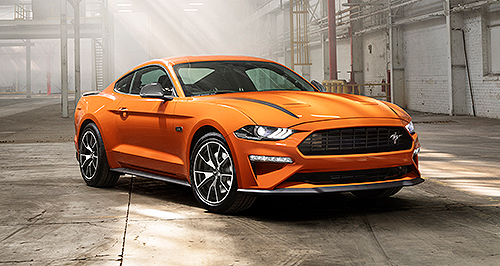Future models - Ford - Mustang - High Performance 2.3LFord gives four-cylinder Mustang a lift for 2020Pony up: Ford Australia will drop the EcoBoost moniker from the four-cylinder Mustang when it introduces an upgraded version in February 2020. Bigger turbo and new name among changes for facelifted four-cylinder Ford Mustang1 Aug 2019 FORD will bolt a bigger twin-scroll turbocharger from the Focus RS onto the four-cylinder Mustang’s 2.3-litre engine to squeeze a little more power and torque out of it for the grandly named High Performance 2.3L to be launched in Australia in February next year.
The new variant – available in both fastback and convertible – will replace the current four-cylinder EcoBoost Mustang in the 2020 range that kicks off with the revised V8 GT in November.
Ford Australia hopes the changes – including much-needed safety upgrades – will help to keep the Mustang at the forefront of Australian sales into the next decade.
Changes to the four-pot version include the V8 GT’s bolder front splitter, fatter anti-roll bars, shorter gear ratios, staggered tyre sizes and a number of visual tweaks such as different badging and grey bonnet ‘spears’ and mirrors to contrast with some fresh body colours that will include retro-style orange and lime green.
Thanks to the bigger, 63mm blower, the revised engine will produce 236kW of power and 448Nm of torque – gains of 12kW and 7Nm respectively over the current model.
Ford says the biggest boost to performance will come from the meatier torque curve that holds at least 90 per cent of peak torque from 2500rpm to 5300rpm.
Mustang chief program engineer Carl Widmann said the power curve power also holds longer, to the 6500rpm red line.
While the High Performance 2.3L becomes the most powerful four-cylinder Mustang, the power falls short of the 257kW generated by the 2.3-litre engine in the most recent version of the hardcore Focus RS that is now in hiatus between models ahead of possible replacement in a couple of years.
No performance figures have yet been proffered for the Mustang, but acceleration times are likely to benefit from shorter gear ratios for both the six-speed manual gearbox and 10-speed automatic transmission.
The manual variant also now shares the automatic’s shorter 3.55:1 final drive, down from 3.31:1.
While the current four-cylinder Mustang has identical 9.0-inch-wide tyres all round, the new version gets a staggered tyre arrangement like the GT, with nine-inchers at the front and 9.5s at the back.
The front stabiliser bar has been boosted to 31mm, while the rear bar goes up to 24mm in a move to improve control and compliance. Like the GT, the MagneRide magnetic suspension is optional. Interior changes include a spun aluminium instrument panel with oil pressure and turbo boost gauges, plus a serialised dash plaque for each numbered vehicle.
Carryover features include leather upholstery and a sports steering wheel.
The Mustang has been Australian’s top-selling sportscar since 2016, and with 2442 sales in 2019 to the end of June, it is well on track to take the crown again in 2019, despite a 16.4 per cent decline in volume compared with the first half of last year.
The Mustang currently holds a 56.4 per cent share of the sportscar segment under $80,000, well ahead of the second-placed BMW 2 Series with 12.4 per cent.  Read more18th of July 2019  Ford Australia confirms MY20 Mustang updateBlack Shadow Pack, four new paintwork options headline incoming Ford Mustang upgrade22nd of October 2018  Ford teases electrified pony carNew-look, Mustang-inspired face for Ford’s new electrified modelAll future models Alfa Romeo Alfa Romeo Abarth Abarth Audi Audi Aston Martin Aston Martin BMW BMW Bentley Bentley Chrysler Chrysler Chevrolet Chevrolet Dodge Dodge Citroen Citroen Ferrari Ferrari DS DS Ford Ford Fiat Fiat FPV FPV Foton Foton Haval Haval Great Wall Great Wall Honda Honda Holden Holden Hyundai Hyundai HSV HSV Isuzu Isuzu Infiniti Infiniti Jeep Jeep Jaguar Jaguar Lamborghini Lamborghini Kia Kia Lexus Lexus Land Rover Land Rover Mazda Mazda Maserati Maserati Mercedes-Benz Mercedes-Benz McLaren McLaren Mini Mini Nissan Nissan Mitsubishi Mitsubishi Peugeot Peugeot Opel Opel Proton Proton Porsche Porsche Renault Renault Ram Ram Saab Saab Rolls-Royce Rolls-Royce Smart Smart Skoda Skoda Subaru Subaru SsangYong SsangYong Tesla Tesla Suzuki Suzuki Toyota Toyota Volvo VolvoMustang pricingMotor industry news |
Click to shareFord modelsAll future models Alfa Romeo Alfa Romeo Abarth Abarth Audi Audi Aston Martin Aston Martin BMW BMW Bentley Bentley Chrysler Chrysler Chevrolet Chevrolet Dodge Dodge Citroen Citroen Ferrari Ferrari DS DS Ford Ford Fiat Fiat FPV FPV Foton Foton Haval Haval Great Wall Great Wall Honda Honda Holden Holden Hyundai Hyundai HSV HSV Isuzu Isuzu Infiniti Infiniti Jeep Jeep Jaguar Jaguar Lamborghini Lamborghini Kia Kia Lexus Lexus Land Rover Land Rover Mazda Mazda Maserati Maserati Mercedes-Benz Mercedes-Benz McLaren McLaren Mini Mini Nissan Nissan Mitsubishi Mitsubishi Peugeot Peugeot Opel Opel Proton Proton Porsche Porsche Renault Renault Ram Ram Saab Saab Rolls-Royce Rolls-Royce Smart Smart Skoda Skoda Subaru Subaru SsangYong SsangYong Tesla Tesla Suzuki Suzuki Toyota Toyota Volvo VolvoMustang pricingMotor industry news |
















Facebook Twitter Instagram